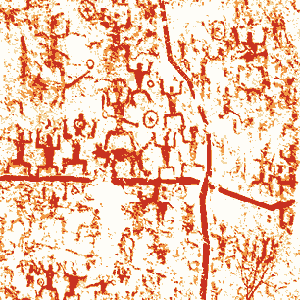 COM.on C.A.1:e3/7-21
Online published on May 7, 2007.
COM.on C.A.1:e3/7-21
Online published on May 7, 2007.
doi:10.4236/coca.2007.11003
REVIEW
Origin and
Classification of Zhuang Analyzed by
Paternal Genetic Structure
CHEN Jing
Synthetic Laboratory, The First
Affiliated Hospital, Chinese Medicine
College of Guangxi, Nanning 530023,
China
Editor's Summary:
Zhuang is the most populated minority
group in China. They mainly reside in
South China, where is probably one of
the most important entrances of early
modern humans into East Asia. This paper
analyzed Y-SNP and Y-STR variations in
Zhuang populations from different
regions of South China, and the results
demonstrate a West-East distinction in
the paternal lineage, which is different
from the North-South structure as
indicated by linguistic data. The author
thus provides interesting clues for the
genetic anthropological studies of East
Asians, especially the Daic-speaking
populations. (WEN Bo, Department of
Medicine, Johns Hopkins University)
ABSTRACT:
The Zhuang
nationality, the largest minority in
China, is quite close to the Thai and
the Lao in culture, and therefore, plays
an important role in the genetic
structure study of the East Asian
population. However, without a formal
written language, it is quite difficult
to trace the origins and migration
history of the Zhuang with the
existenting Chinese records. The only
classification of Zhuang populations is
by language. Zhuang people can be
classified into northern and southern
groups based on their dialects. In order
to understand the Zhuang's internal
genetic structure, the DNA diversity of
eight Zhuang branches were investigated
after determining their Y chromosome
haplotypes that represent paternal
inheritance with 18 East Asia specific
Y-chromosome biallelic markers, 7
Y-chromosome STR markers. RFLP,
fluorescence-PCR techniques and detail
genetics analyses such as principal
component, hierarchical clustering and
AMOVA analysis were performed . As a
result, on Y-chromosome, O*, O2a and O1
were found to be the most common
haplogroups in Zhuang populations. Here
O* and O2a were the native component;
O1, the core component of Baiyue from
eastern China, was brought to Zhuang
later; and finally, O3 from northern Han
was introduced. This result is quite
consistent with historical records and
other anthropological studies. In
addition, a Hongshuihe-centric,
east-to-west gradient change rather than
an expected south-north profile was
observed in the genetic structure of the
Zhuang, whereas various genetic analyses
were performed, indicating that the
traditionally linguistic classification
of northern and southern Zhuang groups
is short of genetic support.
Key
words: Y chromosome; Zhuang;
Internal genetic structure; Multiple
origin
《现代人类学通讯》第一卷e3篇 第7-21页 2007年5月7日网上发行
特约综述
从父系遗传结构分析壮族的起源与分类
陈晶
广西中医学院第一附属医院综合实验室,中国 南宁 530023
编辑提要:壮族是中国人口最多的少数民族,又由于其处于东亚人群最可能的入口地区之一,在中国人群早期起源研究中有独特的地位。该文比较系统地分析了中国南方各地壮族人群的Y-SNP,Y-STR多态性,并对其父系遗传结构及其起源和扩散进行了探讨。结果显示壮族在父系遗传上有明显的东西分化,与语言上的南北分化完全不同。该论文提供的数据及结论对东亚人群,特别是百越系人群的遗传人类学研究有一定的借鉴意义。(文波,约翰霍普金斯大学医学系)
摘要:壮族是中国最大的少数民族,与东南亚广泛分布的泰老族群有着密切的关系,在东亚人群的遗传结构研究中地位非常特殊。然而,由于壮民族缺乏通用的本族文字,历经数千年的发展,壮民族内部人群的迁徙融合及交流状况很难在现有的文字资料中有所发现。仅有的材料是从语言上将壮族人群区分为壮语北部方言组和南部方言组。为了解壮族人群的内部遗传结构,我们从父系遗传物质Y染色体入手,根据东亚人群特异的18个Y染色体双等位标记,7个Y-STR标记,对壮族各个支系共八个人群的DNA样本进行限制性长度片段多态酶切、荧光PCR确定SNP、STR等实验技术分析,及主成份分析、聚类分析、分子方差分析等多种遗传学分析技术,调查了壮族各个支系的DNA多样性,分别确定其Y-SNP、Y-STR,揭示壮族的内部遗传结构。结果发现,壮族的主要Y染色体单倍群为O*、O2a、O1。壮族的遗传结构中有几个层次,最早的O*、O2a成分普遍出现在各个支系中,第二层是由东部来的百越核心成分O1,第三层是北方来的汉族成分O3,与壮族的历史事件和其他人类学研究基本一致。壮族支系遗传结构体现出以红水河支系为中心从东往西的梯度变化过程。传统的对壮族按方言分为南北二组的分类方法并没有在遗传学上获得相应的支持。
关键词:Y染色体;壮族;内部遗传结构;多起源
参考文献
References
1. 张声震(1997) 壮族通史. 北京:民族出版社.
2. 班固(汉)汉书,卷二十八下.地理志第八下.粤地注一. 3. 刘安(汉)淮南子,卷十八,人间训.
3. 刘安(汉)淮南子,卷十八,人间训. 4. 司马迁(汉)史记,卷一百一十三,南越列传第五十三.
4. 司马迁(汉)史记,卷一百一十三,南越列传第五十三. 5. 桓宽(汉)盐铁论,卷四,地广第十六.
5. 桓宽(汉)盐铁论,卷四,地广第十六. 6. 郦道元(北魏)水注经,卷三十七,淹水叶榆河夷水油水澧水沅水泿水.
6. 郦道元(北魏)水注经,卷三十七,淹水叶榆河夷水油水澧水沅水泿水. 7. The Y Chromosome Consortium(2002) A nomenclature system for the tree of human Y-chromosomal binary haplogroups. Genome Res 12:339- 348.
7. The Y Chromosome Consortium(2002) A nomenclature system for the tree of human Y-chromosomal binary haplogroups. Genome Res 12:339- 348.
8. Lahn BT, Pearson NM, Jagalian K(2001) The human Y chromosome, in the light of evolution. Nat Rev Genet, 2(3):207-16.
9. Skaletsky H, Kuroda-Kawaguchi T, Minx PJ, Cordum HS, Hillier L, Brown LG, Repping S, Pyntikova T, Ali J, Bieri T, Chinwalla A, Delehaunty A, Delehaunty K, Du H, Fewell G, Fulton L, Fulton R, Graves T, Hou SF, Latrielle P, Leonard S, Mardis E, Maupin R, McPherson J, Miner T, Nash W, Nguyen C, Ozersky P, Pepin K, Rock S, Rohlfing T, Scott K, Schultz B, Strong C, Tin-Wollam A, Yang SP, Waterston RH, Wilson RK, Rozen S, Page DC (2003) The male-specific region of the human Y chromosome is a mosaic of discrete sequence classes. Nature 423(6942):825-37.
10. Seielstad M, Bekele E, Ibrahim M, Toure A, Traore M. (1999) A view of modern human origins from Y chromosome microsatellite variation. Genome Res 9(6): 558-67.
11. Underhill PA, Shen P, Lin AA, Jin L, Passarino G, Yang WH, Kauffman E, Bonné-Tamir B, Bertranpetit J, Francalacci P, Ibrahim M, Jenkins T, Kidd K, Mehdi SQ, Seielstad MT, Wells RS, Piazza A, Davis RW, Feldman MW, Cavalli-Sforza LL, Oefner P(2000) Y chromosome sequence variation and the history of human populations. Nat Genet 26:358-361.
12. Underhill PA, Passarino G, Lin AA, Shen P, Mirazon Lahr M, Foley RA, Oefner PJ, Cavalli-Sforza LL(2001) The Phylogeography of Y Chromosome Binary Haplotypes and the Origins of Modern Human Populations. Annals of Human Genetics 65 (Pt 1): 43-62.
13. Anderson S, Bankier AT, Barrell BG, de Bruijn MH, Coulson AR, Drouin J, Eperon IC, Nierlich DP, Roe BA, Sanger F, Schreier PH, Smith AJ, Staden R, Young IG (1981) Sequence and organization of the human mitochondrial genome. Nature 290:457-65.
14. Cann RL, Stoneking M, Wilson AC (1987) Mitochondrial DNA and human evolution. Nature 325 (6099):31-36.
15. Wallace DC, Brown MD, Lott MT(1999) Nucleotide Mitochondrial DNA variation in human evolution and disease. Gene 238:211-30.
16. Kivisild T, Tolk HV, Parik J, Wang Y, Papiha SS, Bandelt HJ, Villems R(2002) The emerging limbs and twigs of the East Asian mtDNA tree. Mol Biol Evol 19:1737 1751.
17. Vigilant L, Stoneking M, Harpending H, Hawkes K, Wilson AC (1991) African populations and the evolution of human mitochondrial DNA. Science 253:1503-1507.
18. Su B, Xiao J, Underhill P, Deka R, Zhang W, Akey J, Huang W, Shen D, Lu D, Luo J, Chu J, Tan J, Shen P, Davis R, Cavalli-Sforza LL, Chakraborty R, Xiong M, Du R, Oefner P, Chen Z, Jin L(1999) Y chromosome Evidence for a northward migration of modern humans in East Asia during the last Ice Age. Am J Hum Genet 65: 1718-1724.
19. Wen B, Li H, Lu D, Song X, Zhang F, He Y, Li F, Gao Y, Mao X, Zhang L, Qian J, Tan J, Jin J, Huang W, Deka R, Su B, Chakraborty R, Jin L (2004) Genetic evidence supports demic diffusion of Han culture. Nature 431:302-305.
20. Karafet T, Xu L, Du R, Wang W, Feng S, Wells RS, Redd AJ, Zegura SL, Hammer MF (2001) Paternal population history of East Asia: sources, patterns, and microevolutionary processes. Am J Hum Genet 69(3):615-28.
21. Kong QP, Yao YG, Sun C, Bandelt HJ, Zhu CL, Zhang YP(2003) Phylogeny of east Asian mitochondrial DNA lineages inferred from complete sequences. Am J Hum Genet 73:671-6.
22. 李辉(2002)百越遗传结构的一元二分迹象.广西民族研究 70(4):26-31. 23. 董永利,杨智丽,石宏,高路,鲁靖,程宝文,李开源,昝瑞光,肖春杰(2004) 云南18个民族Y染色体双等位基因单倍型频率的主成分分析. 遗传学报, 31(10):1030-1036.
23. 董永利,杨智丽,石宏,高路,鲁靖,程宝文,李开源,昝瑞光,肖春杰(2004) 云南18个民族Y染色体双等位基因单倍型频率的主成分分析. 遗传学报, 31(10):1030-1036. 24. 李永念,左丽,文波,柯越海,黄薇,金力(2002)中国布依族人的起源及迁移初探——来自Y染色体和线粒体的线索. 遗传学报, 29:196-200.
24. 李永念,左丽,文波,柯越海,黄薇,金力(2002)中国布依族人的起源及迁移初探——来自Y染色体和线粒体的线索. 遗传学报, 29:196-200. 25. 金力,褚嘉祐(2006)中华民族遗传多样性研究. 上海:上海科学技术出版社.
25. 金力,褚嘉祐(2006)中华民族遗传多样性研究. 上海:上海科学技术出版社.
26. Butler JM, Schoske R, Vallone PM, Kline MC, Redd AJ, Hammer MF (2002) A novel multiplex for simultaneous amplification of 20 Y chromosome STR markers. Forensic Sci Int 129(1):10-24.
 COM.on C.A.1:e3/7-21
Online published on May 7, 2007.
COM.on C.A.1:e3/7-21
Online published on May 7, 2007. COM.on C.A.1:e3/7-21
Online published on May 7, 2007.
COM.on C.A.1:e3/7-21
Online published on May 7, 2007.